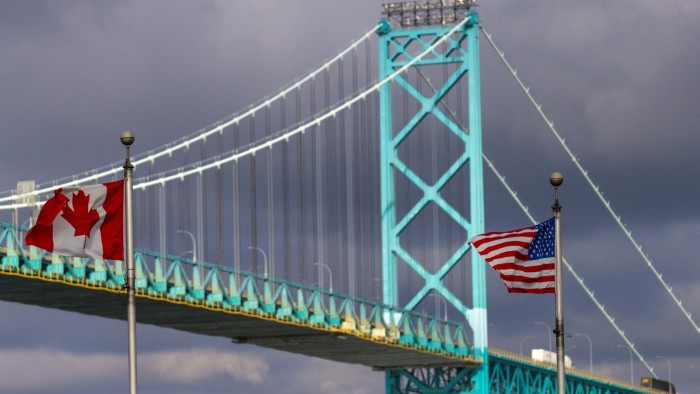After spending months talking up Canada’s relationship with the US, Prime Minister Justin Trudeau will convene an economic summit on Friday with a new focus: promoting his country’s trade with the rest of the world.
The goal of the Canada-US Economic Summit will be to “make it easier to build and trade within our borders, and diversify export markets”, Trudeau said on Wednesday.
The move comes days after Trudeau negotiated a 30-day reprieve from Donald Trump’s plan to impose tariffs of 25 per cent on Canadian imports into the US, except energy, which would be taxed at 10 per cent.
After decades of free trade between the US and Canada, the American president’s tariff threat to a relationship worth C$1.3tn ($91bn) has prompted a reckoning among policymakers about how to curb the country’s dependence on its southern neighbour — and how to recalibrate its economy.
“Canada’s strategy for the past 30 years has relied on trade agreements . . . that Trump has disrupted, and no longer can be relied on as a business case for Canada,” said John Manley, a former finance minister.
Trudeau has summoned chief executives, policy experts and labour unions to Toronto alongside his Council on Canada-US Relations, which includes the heads of major auto parts companies and several former provincial premiers.
His effort to rally the business community reflects an anxiety that Canadian companies may no longer enjoy unfettered access to the world’s biggest economy.
Trump’s threatened trade war comes at a time of acute political turmoil for Canada. Trudeau last month suspended parliament to buy time for his governing Liberal party to choose a new leader before facing a general election this year.
The prime minister is leaving office with a dismal popularity rating, but his handling of Trump has won praise even from opponents. Trump’s threat to Canada — and his frequent taunts — have sparked a burst of patriotism.
More than 90 per cent of Canadians now favour greater economic independence from the US, up from 59 per cent before Trump’s tariff threat, according to a poll from the Angus Reid Institute.
“Trump should be the wake-up call. We have a really big economic challenge on our hands . . . We have been so complacent in relying on the United States,” said Martha Hall Findlay, director of the School of Public Policy at the University of Calgary.
Over 50 years Canada has fallen from being the sixth most-productive economy in the OECD to 18th in 2022. In the G7, it now ranks sixth. Labour productivity in 2024 was 1.2 per cent below pre-pandemic levels, having fallen in 14 of the past 16 quarters.
International trade has grown twice as fast as internal trade since 2010, according to Scotiabank Economics. Canada sends 77 per cent of its exported goods to the US, and no other marker is bigger than 5 per cent, Scotia said.
Among the loudest complaints from industry and some experts is that Canada’s leaders, including Trudeau, have not built energy infrastructure to allow Canada to sell its oil and gas overseas.
The Trudeau government did fund the Trans Mountain Expansion pipeline to Canada’s west coast — allowing more exports to Asia — that opened in May last year after more than a decade of development and at a cost of C$34bn, four times over budget.
But the Trump turmoil has reignited debate over previously cancelled projects such as Energy East, which would have sent oil from Alberta to as far away as Canada’s eastern Atlantic coast, and Northern Gateway, another project to export heavy oil to the Pacific coast.
“If we cut the red tape we could have a pipeline built in two years,” said Adam Waterous, chief executive of Strathcona Resources, Canada’s fifth-largest oil producer.
He added the US bought “liquid gold at liquid silver prices” because “Canada has no other options” but to ship most of its oil to refiners south of the border.

Andrew Leach, an energy and environmental economist at the University of Alberta, said huge investment was needed to build pipelines but the projects also needed backing from Canada’s provinces, First Nations groups and environmentalists as well as the federal government.
The country’s oil industry would “happily move oil and gas to the west coast instead of the US midwest, it makes sense to do this”, he said. “But this recent blaming of Trudeau for the lack of pipeline options seems to forget the Conservatives were in power for a decade before him.”
Since Trump’s tariffs threats in recent days, politicians have been quicker to swing behind boosting Canada’s internal trade.
Canada’s provinces protect their local industries such as farming and alcohol. Differing regulation means workers cannot always move their credentials to other regions. Truck drivers also face headaches, including different rules for the weights of vehicles in different jurisdictions at different times of the year.
Trudeau’s minister of internal trade, Anita Anand, has been leading efforts to break these barriers — a move she said “will potentially add up to C$200bn to the Canadian economy”.
But decades of effort have gone into easing this internal trade friction, and the obstacles remain.
Many officials and experts are sceptical about how much can be achieved to boost Canada’s economic independence from the US, given the inescapable reality of geography and the countries’ relative size.
Those pushing for greater economic self-reliance argue Canada has little choice — and point out that America’s economic turn inwards is not unique to Trump. Even Barack Obama set off alarm bells in Canada with his talk of “Buy American” policies.
Leach said there were lessons for Canada from the UK’s experience after Brexit.
“Canada is next to the world’s largest free market economy,” he said. “And while the US is doing this to us, if you decide to separate from them completely, it can end badly.”
https://www.ft.com/content/5f2b1e1a-1a42-4306-9f21-4066b31b1ee4


